Burnley and District Tramways
History
Powers to build 7.02 miles of steam tramway between Padiham, Burnley, Brierfield and Nelson were granted to Ernest George Fellowe and John Warrington Morris on the 11th August 1879, by the Burnley and District Tramways Order 1879, which was passed into law under the Tramways Orders Confirmation Act 1879.
A company was soon set up to build and operate the tramway — the Burnley and District Tramways Company — in which the Tramway and General Works Company Limited was a major shareholder; in all likelihood, the promoters would either have been acting on behalf of the T&GWCo in promoting the tramway order, or else they would have had an agreement with them to finance the scheme once powers were obtained.
The company was unfortunately handicapped before services had even started, when the Board of Trade refused to licence Church Street in Burnley for steam traction due to its narrowness, effectively splitting the proposed system in two. Despite this set back, the first section of the standard-gauge steam tramway — northwards to Nelson — opened for business on the 17th September 1881. This was followed a week later (on the 24th September 1881) by the line westwards to Padiham. Horse traction was introduced on the short connecting section along Church Street, with trams waiting for each other at both ends of the horse-worked section and inevitably obstructing other traffic, which quickly drew the ire of both residents and the council alike. This was not the only problem, as the company seems to have been poorly managed from the off, with services proving to be anything but reliable. Far worse was, however, to come, as the company was repeatedly summonsed for offences against the Tramways Act, primarily for the emission of steam. The first few cases turned into a torrent, week in, week out, the company being continually fined. The company's engines were Kitsons, which were operating without adverse comment on many other tramways, yet in Burnley , the police and magistrates considered them, and more specifically the steam emissions, to be a danger to life! The magistrates blamed the company, the company blamed the engines, and Kitsons blamed the drivers. The engines were subsequently modified by Kitsons, but the steam emissions continued, as did the fines.
Before these trials and tribulations, the company had clearly been confident of the line's potential, having submitted an application to build a 1.54-mile extension from Nelson to Barrowford Bridge. Powers for the extension were granted by the Burnley and District Tramways Extension Order 1882, which was passed into law on the 24th July 1882 under the Tramways Orders Confirmation (No.1) Act, 1882.
It is difficult at this remove to see why steam emissions, as opposed to smoke emissions, were considered such a problem —one that was frankly impossible to eliminate on cold days with the available technology — when all around factory chimneys and domestic dwellings were free to pour forth as much smoke as they desired. What is certain, however, is that the company was pursued relentlessly by the police, and whilst the truth will probably never be known, the sheer volume of the prosecutions hints at vested interests, probably the carriage-owning classes, a supposition supported by the statement of a police superintendent, who admitted that he had been directed — by the Assistant Chief Constable —to proceed against the company "somewhat vigorously" in respect of steam emissions. Ironically, the Chief Magistrate, who seems to have been fond of levying the maximum as far as fines were concerned, was also the Mayor.
The company simply had no other option but to introduce horse traction to supplement the engines, and eventually, around the 1st March 1882, to replace them altogether. The corporation and various burghers finally managed to rouse themselves and come to the company's defence, when it became clear that the town was not only in danger of losing the steam trams, but also the tramway itself. The company were almost at the point of throwing in the towel, horse traction being not only expensive, but palpably unsuited to the terrain. Despite vocal critiscim of the prosecutions, including by other local authorities, nothing really changed, the company struggling on, killing horses at the rate of one a week.
Various new engines were brought in on trial, and as witnessed by yet more summonses, the company also ran some of the Kitsons, presumably as and when it thought they would not emit steam. New Falcon-built engines were, however finally purchased in 1893, which seem to have mollified the opposition, and by August of that year, services had improved significantly, though some horses were kept in reserve until 1885. Through services via a widened Church Street were finally introduced in February 1885, but only after a lot of squabbling between the corporation and the company over payment, the former demanding £1000 for a scheme it had apparently planned before the tramway had ever been heard of.
The company was, however, at long last able to settle down to a profitable existence, relatively unmolested by the authorities, and was to pay good dividends throughout its remaining years.
Although further powers were obtained on the 23rd August 1887 under the Burnley and District Tramways Extension Order 1887, which was passed into law by the Tramways Orders Confirmation (No.1) Act 1887, the system remained as built. The standard-gauge tramway comprised a 7.1-mile single line running from Padiham in the west through to Burnley, where it turned northwards through Reedley and Brierfield to its northern terminus in Nelson.
Under the Tramways Act of 1870, the various local authorities through whose territories the tramway ran (Burnley and Nelson Corporations, Padiham and Brierfield Urban District Councils, and Reedley Hallows Parish Council) were entitled to purchase the system 21 years after the passing of the enabling act, i.e., 11th August 1900. Plans were made well in advance to take over the tramway with the aim of converting it to overhead electric traction, the tramway passing into multiple municipal hands on 1st of March 1900. By formal agreement, Burnley Corporation took over operation of the tramway, and continued to run steam trams for another 20 months until it withdrew them completely — on the 17th November 1901— prior to reconstructing and regauging the tramway to the prevailing gauge in north-east lancashire, which was 4ft 0ins.
The Burnley and District Tramways remained an isolated system for its entire existence, its nearest neighbour being the Rossendale Valley Tramways Company, which had its northerm terminus at Crawshawbooth, around 6 miles to the south of Burnley.
Uniforms
Unfortunately no photographs have survived of B&DTCo horse trams or staff, so it is not possible to say whether or not the crews wore uniforms.
Numerous photographs have, however, survived which show B&DTCo steam-tram crews reasonably close up, and these reveal that drivers and stokers (often boys) wore very similar attire to their railway counterparts, namely, heavy cotton trousers and jackets, predominantly light in colour. Headgear also followed railway practice, with photographs invariably showing cotton or soft-topped caps, though trilbies and flat caps also occasionally made an appearance. No badges of any kind were worn, including licences.
Two excellent studio portraits have survived of Conductors No 6 and No 8 of the Burnley and District Tramways Company, clearly showing that conductors wore double-breasted jackets with four pairs of buttons (probably bearing B&DT script initials; see link), three waist pockets (with flaps), a breast pocket (slit) and lapels. The left-hand collar, and very probably the right-hand collar too, bore the word ‘CONDUCTOR’ in embroidered block letters. Caps were in a smart kepi-style with a stiff glossy peak; they bore a large cloth cap badge containing embroidered ‘B&DT’ block initials, above which was an employee number, also embroidered. The general shape of the badge is very reminiscent of several other early tramway companies, e.g., the North Metropolitan Tramways Company (see link). A few photographs exist which show conductors in informal attire — the most likely explanation for this is that they were taken in corporation days, the new owners having understandably chosen to dispense with the B&DT uniforms and caps.
Inspectors, at least in later years, wore single-breasted jackets edged in a finer material than the main body, with hidden buttons (or more likely a hook and eye arrangement) and stand-up collars; the latter probably bore the designation 'INSPECTOR' in embroidered lettering, though this cannot be made out on surviving photographs. Caps were similar to those used by conductors, but with a pom pom on the top.
Further reading
For a history of the B&DTCo, see: 'A History of the British Steam Tram, Volume 2', p209-234, by D Gladwin; Adam Gordon Publishing (2006).
Images
Steam tramway drivers and conductors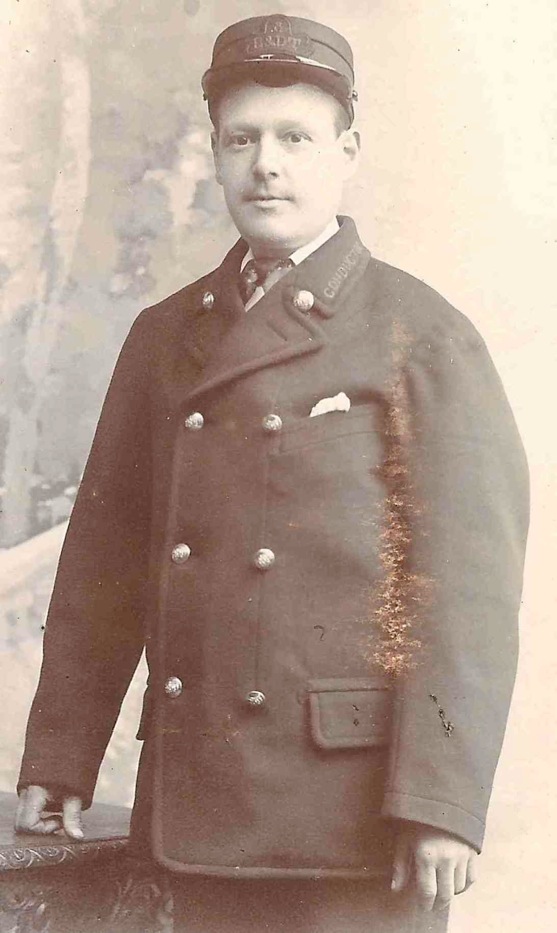
Carte de Visite of B&DTCo Conductor No 8. The card was produced by ’Bancroft and Crabtree of Burnley, Nelson and Bacup’, and although undated, was almost certainly taken certainly taken fairly early on in the tramway's existence, most likely in the early-mid 1880s. Magnification shows the buttons to be script-lettering, 'probably 'B&DT' (see link). Author's Collection.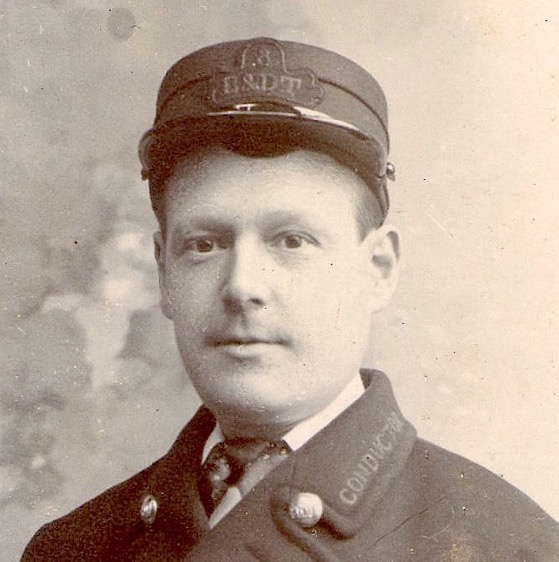
An enlargement of the above photograph showing details of the collar and cap insignia; both are clearly embroidered.
Incredibly, another studio portrait has survived from the same studio, this time of B&DTCo Conductor No 6. Author's Collection.
An elargement of the above photograph showing details of the collar and cap insignia.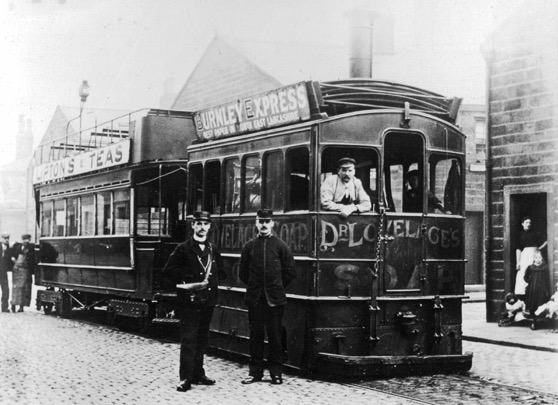
A conductor, an inspector and a driver with an unidentified Falcon steam tram — photo undated, but probably taken in the 1890s. With thanks to the now defunct Bury Image Bank; Image b13748 — copyright Bury Archive Services.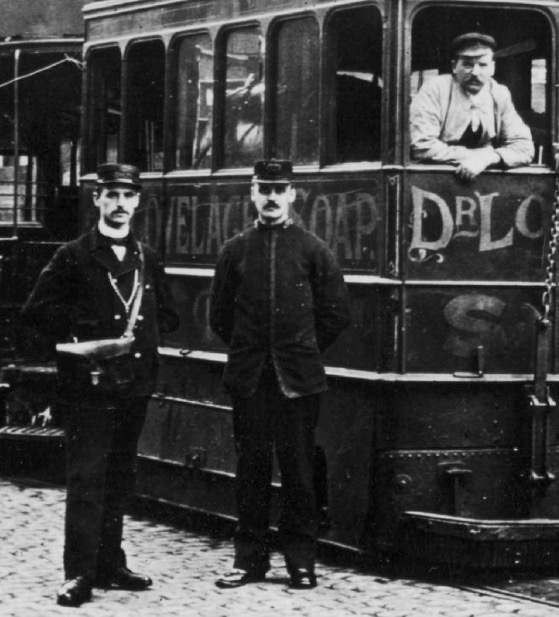
An enlargement of the above photograph showing the crew and the inspector.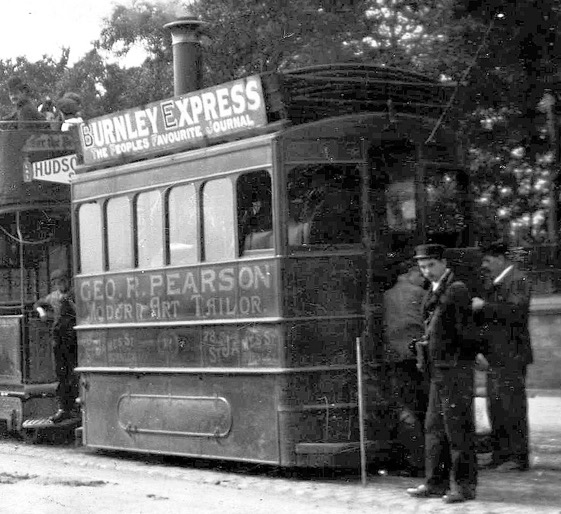
A driver (entering his engine at the front), aconductor and a stoker (on the left) with an unidentified Falcon steam tram — photo undated, but probably taken in the mid 1890s. With thanks to Duncan Holden.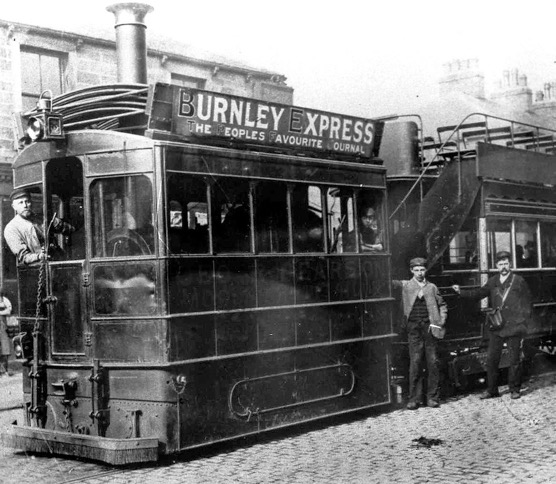
A driver, a stoker and a conductor pose for the cameraman with a reasonable-condition Falcon steam tram — photo undated, but probably taken in the late 1890s. With thanks to Duncan Holden.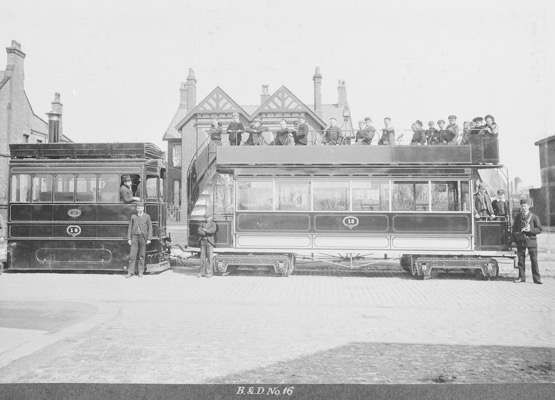
B&DTCo Steam Tram No 16, a Falcon product delivered in 1897, and Trailer (No 15) at Colne Road — photo undated, but almost certainly taken in June 1897, given that another virtually identical photograph has survived which is so dated. This was probably an official company shot, taken when No 16 was new, as both vehicles are yet to be festooned with advertisements, something which the B&DTCo seems to have excelled at! Photo courtesy of the National Tramway Museum.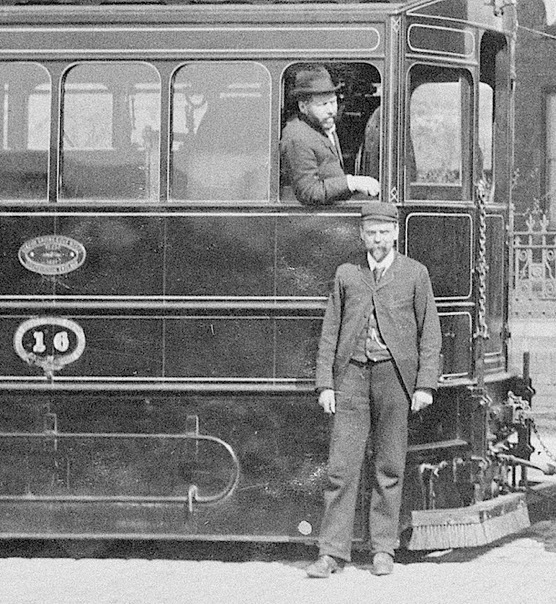
An enlargement of the above photograph showing the driver in his trilby hat.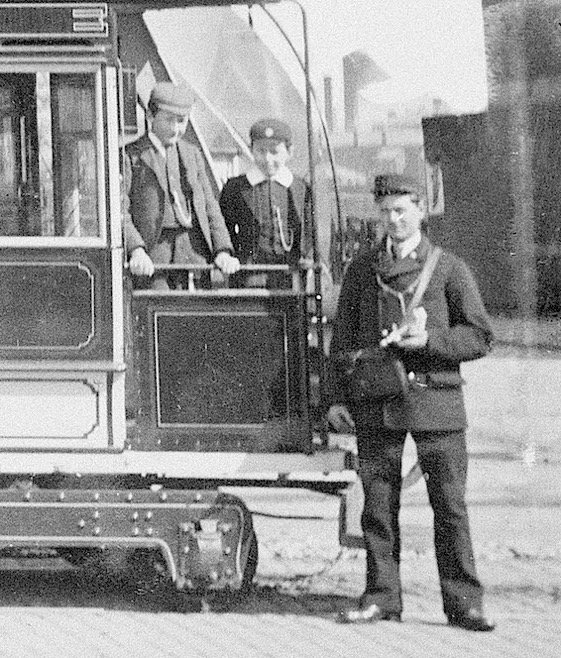
Another blow-up of the above photo, this time showing the conductor in uniform jacket with a kepi-style cap.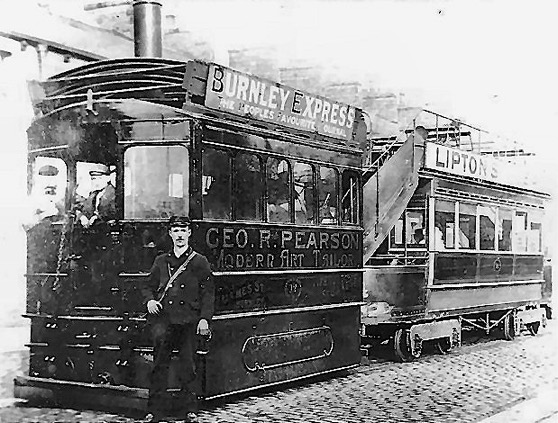
A rather poor-quality photograph, but one which does show the conductor's uniform reasonably well. If the Falcon engine is No 17 (this is not entirely clear), then this would date the photograph to 1897 or later. With thanks to Jim Halsall.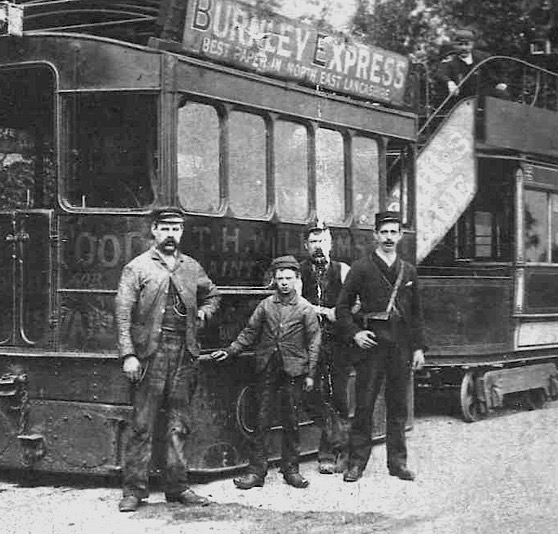
Steam tram engine crew, including a very young stoker, pose for the camera together with their conductor. As was the case with most steam tramways, the footplate crew are appropriately attired for the physical and dirty nature of their work. The conductor also looks distinctly shabby compared with other shots, suggesting that this image may have been taken towards the end of the company's existence or even in corporation days. With thanks to Jim Halsall.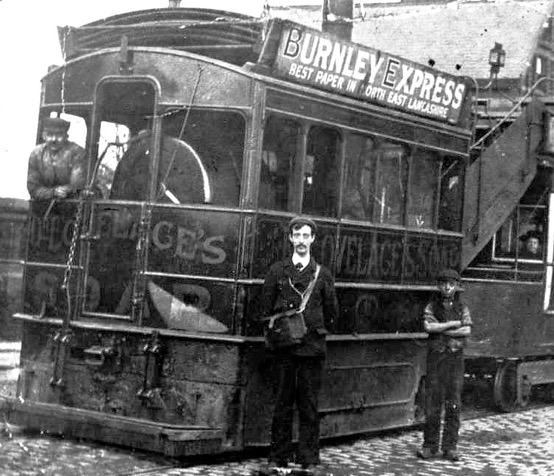
A rather decrepit-looking Falcon engine with a driver, a conductor and a stoker. The photo is undated, though there are reasons to suspect that it is quite late — possibly after the corporation take-over — amongst them, the condition of the tram, and the conductor's informal attire, presumably the result of the corporation dispensing with the old company uniforms. With thanks to Duncan Holden.
Senior staff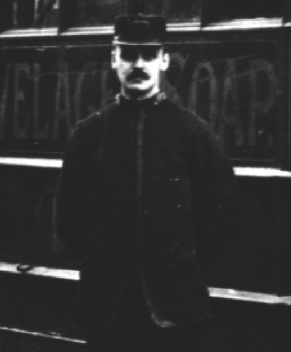
An enlargement of one of the photographs above showing the inspector, in typical tramway inspector's jacket with a kepi-style cap topped with a pom pom.